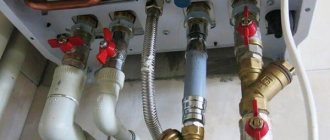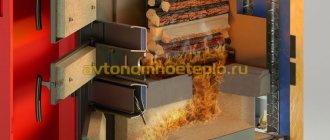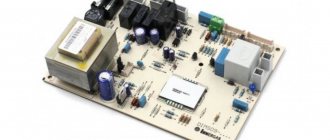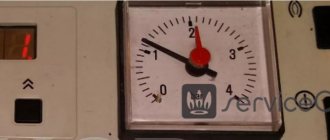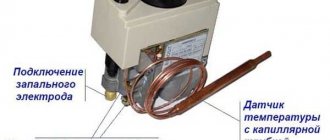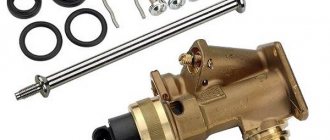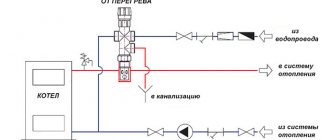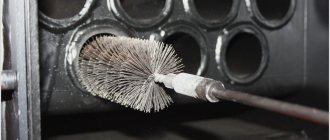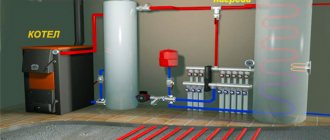Home / Boiler automation
Back
Published: 06/04/2019
Reading time: 7 min
0
2499
To achieve maximum efficiency from the operation of a gas boiler and avoid breakdowns, experts recommend purchasing and installing a voltage stabilizer on it. The types of equipment and ratings of the best models are discussed further in the article.
- 1 Why do you need a stabilizer for a boiler?
- 2 Types of stabilizers 2.1 Electromechanical
- 2.2 Relay
- 2.3 Electronic
- 3.1 Calculation formula:
How to choose a voltage stabilizer for a gas boiler
There are a large number of stabilizers on sale. They differ in the number of phases, power, type and other parameters.
To select a voltage stabilizer for a gas boiler, you should know at least minimal information, how they differ and what parameters are necessary for long-term operation with a gas boiler.
- stabilizer power. In the instructions for the gas boiler you can find information about how much power is required for full operation of the equipment;
- device type. There are not many of them, but they differ from each other;
- operating voltage range in which the device can operate stably;
- reaction time;
- accuracy of output voltage corresponding to 220V.
Additionally, you should consider where the equipment will be installed. There are floor and wall options. If a wall-mounted gas boiler is installed, then using floor-standing options is not always convenient.
Pay attention to the material from which the case is made. It is recommended that the housing be metal. During constant operation, the device may heat up and the plastic case will lose its attractiveness over time.
Stabilizer selection criteria
When choosing a voltage stabilizer for your gas boiler, you should pay attention to several points.
Parameters of the network to which the device is connected
Each model has specific requirements for the voltage supplying the equipment. Most manufacturers indicate in the gas boiler passport a narrowed range of its operating voltage. For example, 210-230 V. This is due to the fact that the vast majority of such devices are single-phase devices designed for a standard voltage of 220 V. For them, only a 10% deviation will be enough for the stabilizer to fail.
It is imperative to take into account the fluctuation in actual voltage that occurs in the network during the day. It is very good to find out the lowest and highest limits of fluctuations, because if the upper limit is “broken”, the device will immediately de-energize the gas boiler. The selected stabilizer model must keep the voltage within strictly specified limits, taking into account the permitted tolerance.
Load size
For the device to operate correctly, it is necessary to determine whether it can cope with the expected load. A low-power model simply will not withstand constant overloads. Buying an overly powerful device is a pointless waste of money. First of all, you need to determine the power consumed by the gas boiler. It can be viewed in the device passport.
Here you need to be very careful not to confuse thermal and electrical power. In this case, you will need an electrical or input one. It is indicated in the “Characteristics” section in numbers with the name W. Whereas the thermal power is indicated in kW. The value taken from the passport must be increased by a third. This will be the reserve necessary for the correct operation of the device.
If you plan to connect not only a boiler, but also a pump to one stabilizer, you need to take into account the full load from both devices. It should be noted that experts do not recommend such an installation, but in practice this often happens. An important nuance is to take into account the starting current of the pump, which in some cases can be three times higher than the rated current. To determine the required stabilizer power, you need to perform the following steps. The pump power is multiplied by three, and the boiler power is added to it. The resulting number is multiplied by a factor of 1.3.
The voltage stabilizer for a floor-mounted gas boiler is more massive. Such devices are less convenient to use, but their cost is lower.
Installation method
Depending on the mounting method, three types of stabilizers are available:
- Wall-mounted. Small devices that are mounted directly on the wall.
- Floor-standing. Devices designed for installation on any horizontal surface.
- Universal. They can be fixed both on a vertical and, if necessary, on a horizontal surface. The most convenient models, since they can be easily reinstalled if necessary.
In general, a boiler stabilizer must meet the following requirements:
- Have power reserves. Most often, a device rated at 250-600 VA will be sufficient.
- Have protection against overload, short circuit and overheating.
- Have a sinusoidal voltage output, otherwise the pump motor will be damaged.
- Have auto start when power supply is turned on after shutdown.
- Have a protective shutdown function in case the voltage goes beyond safety limits, the so-called “voltage cut-off”.
- Have a grounding terminal.
And a few more tips from practitioners:
- In areas with intensive development and in areas served by old substations, power surges are very common. In such conditions, the optimal choice is a thyristor stabilizer.
- If the passport of the stabilizer model you like indicates that it operates in a range of about 200 V, or even more, you should be wary of such a device. Most often, the quality of the output voltage will be insufficient. In this case, special attention should be paid to the country of assembly and manufacturer. His reputation will be a guarantee of quality.
When choosing between a floor-mounted and a wall-mounted device, preference should be given to the second option. Such devices significantly save space, and the risk of accidental mechanical damage is minimal.
Wall-mounted voltage stabilizers are very convenient. The devices are compact, resistant to mechanical damage, but their cost is slightly higher than that of floor-mounted devices.
Stabilizer requirements
If you decide to install a stabilizer to a gas boiler, then you need to understand the differences between existing models.
Number of phases
Everything is simple here. For full operation of the boiler with electronic equipment, zero and one phase are required. Following this information, we conclude that a single-phase option will be required.
How much power does a stabilizer need?
Most medium-sized heating boilers have power parameters ranging from 8 to 25 kW. If you already have a boiler installed, or you purchased it for further installation, take a look at the operating instructions.
It remains to find the parameter Nominal electrical power. Take the number and add 30%. The resulting value will correspond to the required power parameters.
If you don’t have a boiler yet and you don’t know the power, then purchase a stabilizer with a power of at least 400 W or 0.4 kW.
When purchasing, you should pay attention to the designation. Some manufacturers may list watts (W), while others list volt-amperes (VA). If the characteristics indicate VA, then to find out the power it is necessary to multiply the indicated figure by 0.7. After calculations, get the power value.
Type
The following types can be found on sale:
- electromechanical;
- relay;
- electronic;
- inverter
Does the boiler need a stabilizer?
On forums, in topics where a voltage stabilizer for a gas boiler is discussed, there are directly opposite opinions:
- A stabilizer is not needed; the boiler works perfectly without it throughout its entire service life.
- The boiler must be connected through a stabilizer, otherwise the likelihood of its failure is very high.
Both points of view are supported by facts.
The operating instructions for absolutely all boilers do not specify special requirements for the supply voltage. They say that the equipment is connected to a household network of 230 (240, depending on the country of origin) V, 50 Hz. Additional conditions, such as permissible deviations in voltage and frequency, the content of higher harmonics (non-sinusoidal voltage) are not specified.
Nowadays there is quite a large selection of stabilizers in stores.
In general, this means that the built-in power supply of the electronic unit provides the required supply voltage for the circuit at a mains voltage that complies with the standard. At the same time, the normal operation of other electrical equipment included in the boiler installation is guaranteed, in particular, the pump that creates excess pressure for forced circulation of the coolant.
The European standard establishes a nominal network voltage of 230 V with a tolerance of +/- 5% for a long time and +/- 10% for a short time. Those. the system will operate without failures and failure of components in the network voltage range of 207-253V.
At the moment, the Russian mains voltage standard is consistent with the European one, the nominal value is 230V, and permissible deviations are no more than 10% in any direction.
At the same time, manufacturers do not consider failure of boiler equipment due to mains voltage deviations greater than those established by the standard as a warranty case. Accordingly, if sags or overvoltages in the network exceed the permitted limits (the voltage drops below 207V or rises above 253V), stabilization becomes necessary.
Many manufacturers of heating equipment may refuse a warranty without a voltage stabilizer in the heating system.
Thus, the user must make a decision about purchasing a stabilizer based on his own network stability data. Of course, in case of deviation from the standard, it is possible to file claims against the electricity provider, including in court, but this process is lengthy and will not help protect the boiler from failure.
Expert opinion
Grebnev Vadim Savelievich
Heating system installer
Some boiler manufacturers indicate permissible supply voltage deviations in the operating documentation. As a rule, this is done by companies whose products allow operation under sags/overvoltages greater than standard ones.
Which voltage stabilizer to choose for a gas boiler
In specialized stores you can find many different models that differ in type, power or price. How not to make a mistake and choose the model that will match the gas boiler?
It is impossible to talk about all the models; here is a list of stabilizers that are at the top of the equipment ratings.
Resanta ach 500 1 ct
For those who like the mobility of the device. Weight is 2 kg. Stabilizes voltage from 140 to 260 V. Installed on a horizontal plane.
If a short circuit occurs, the protection disconnects the device from the network. There is a large display on the front. Next to it are two buttons. The device contains a fuse that protects the device from severe overloads.
Pros:
- there is a carrying handle on the body;
- the device has a compact size;
- low price;
- response time is 7 ms.
Minuses:
- stops working at sub-zero temperatures;
- no activation delay function;
- low power.
Bastion teplocom st 555
The device is small in size and light in weight. Capable of equalizing incoming voltage. The model was designed specifically for use in heating systems. There is a remote socket.
Can be used in basements with high humidity.
Pros:
- light weight and compact dimensions;
- is able to accurately show existing parameters;
- Has a bright LED indication.
Minuses:
- makes loud clicking noises during operation;
- output voltage may be unstable;
- In some cases, instability in work may occur.
Sven avr slim 500
Device type – relay. Power is 400 W. Capable of operating at a voltage of 140-260 V. The equipment can operate at temperatures from 0 to 40 degrees.
The device has a durable metal body. A toroidal transformer is installed inside. There is an overheat sensor. There is a display on the front side that can separately show the input or output voltage. The mode is selected using a button.
The design provides for wall mounting, but if necessary, you can put it in a convenient place. The thickness is 6 cm.
Powerman avs 1000d
Stabilizer type – linear. The power of the device is 700 W. Operates with input voltage from 140 to 260 V. Temperature range - from 0 to 40 degrees. When the operating range of the device decreases or increases by 20 V, the device turns off.
There are two displays on the front that show the input and output voltage. The device is made in a floor-standing design, which causes some inconvenience if a wall-mounted version of the heating boiler is used.
The manufacturer mentions protection against interference, but during disassembly we could not find any filter elements.
Rucelf boiler 600
The device has a compact size. The body is treated with an anti-corrosion coating. For ventilation of heating parts, holes are provided on the housing. There is the possibility of wall installation (mounting kit included). Pulse protection is carried out by two varistors, which are installed at the input and output.
Pros:
- toroidal transformer;
- light weight;
- operating range from 150 to 250 V;
- response – 10 ms.
Minuses:
- low stabilization accuracy;
- not recommended for use at sub-zero temperatures;
- Inaccurate output voltage information.
Energy apc 500
Has good technical parameters. Differs in quality and functional features. For short periods it can withstand up to 150% power overload.
The power of the device is 350 W. Response time – 10 ms. Input voltage – from 85 to 270 V.
Calm InStab is550
One of the most popular and best voltage stabilizers for a gas boiler. The inverter converter ensures silent operation of the device. The exception is more powerful models with installed fans.
The output contains an ideal sinusoid, which does not depend on the input voltage. The device has a compact size. The inverter voltage stabilizer has a filter that removes any distortion at the output. There is electronic short circuit protection.
Calm r600st
Device type – electronic. Power is 480 W. Input voltage from 165 to 265 V. Capable of operating at temperatures from 1 to 40 degrees.
The device is manufactured in Russia and meets international requirements. The electronic type of the device ensures complete silence during operation. Cooling of parts occurs due to air movement.
Widely used in banking, medical institutions and other places where equipment reliability is required.
Safe power supply to boilers. Surge Protectors.
Every home has life support systems: water supply, heating, electricity, sewerage, ventilation.
There are many requirements for their reliability and stability in operation. The functionality of life support systems determines high-quality power supply. The alternating current in the house must meet certain standards: the voltage deviation from 220 V should not exceed 5–10%, the frequency of the alternating current is 50 Hz, the voltage waveform is a pure sinusoid, the network must be free of high-frequency interference and interference. If the boiler stops working in winter, this can lead to room cooling, defrosting of pipes, batteries and repairs.
Do you need a voltage stabilizer for your boiler? Before answering this question, you need to understand for which boilers it is needed and why?
Heating boilers come in 2 classes: non-volatile (operate without being connected to the electrical network) and volatile (connected to a stationary AC main). For non-volatile boilers, a voltage stabilizer is not needed; it can be installed on circulation pumps that ensure the flow of liquid through the pipes. Boilers that operate only in the presence of alternating current, on the contrary, require a voltage stabilizer. Many manufacturers of heating boilers do not provide warranty repairs if they were not connected through voltage stabilizers.
An AC voltage stabilizer for a volatile boiler determines the reliability of the entire heating system and the durability of its operation.
What functionality do voltage protection devices have? The main purpose of this device is to stabilize the mains voltage and protect against short circuits. Some models have filters to suppress high-frequency interference and interference; Italian stabilizers have lightning protection. A device for normalizing voltage does not change its shape. Many people mistakenly try to install a stabilizer after the generator so that it changes the sawtooth shape to a sinusoidal one. It is very important to place a voltage stabilizer in front of the gas boiler, since the automation is very demanding on the quality of alternating current and can fail at low or high voltage. Basic requirements for voltage stabilizers for gas boilers:
- performance (semiconductor switches),
- reliability (it is provided by domestic manufacturers),
- compact sizes,
- Possibility of placement on the wall.
Tula stabilizers “Shtil” of the ST and SPT series meet these requirements. They have a high-quality transformer with copper winding, triac switches, and a compact case that can be placed on a wall or floor.
There are also heating boilers that run on diesel fuel. A voltage stabilizer for a diesel boiler should have the same functionality as a device for a gas heating system, but its power should be higher. As a stabilizer for a diesel heating boiler and circulation pumps, you can consider Pskov Progress T series stabilizers (models 1000T, 1500T and 2000T) and Tula Shtil devices 1200 SPT and 2000 SPT.
The third type of heating systems is boilers that run on solid fuel (solid fuel boilers) - wood or coal. Solid fuel heating equipment operates without electricity supply, but circulation pumps installed next to the boiler require alternating current. Therefore, a solid fuel boiler will require low-power stabilizers that will protect the heating system pumps.
Do you need a voltage stabilizer for an electric boiler or boiler? If the voltage in the house is below 220 V, then the time it takes to heat the water to the required temperature will increase. Conversely, if the voltage is higher than 220 V, then the heating element will work intensively, but its service life will decrease. The power of an electrical appliance depends on the value of the alternating current voltage, and if it is approximately equal to 220 V, then for any household appliance this means operating with the parameters specified by the manufacturer.
Stabilizers for electric boilers differ in characteristics from devices for household heating boilers with low-power automation, extremely sensitive to alternating current parameters. The heating element of an electric boiler is not sensitive to voltage drops, interference and interference; it is important that the voltage deviates only slightly from the standard value (in this case, the spiral consumes a lot of power, equal to several kilowatts). A stabilizer for an electric boiler must be powerful; accuracy and speed are not important for it. The Pskov enterprise, which has been producing Progress stabilizers since 2011, began production of budget Status devices. For an electric boiler, you can consider devices with a power of 3000 VA and 5000 VA or Progress 3000T and 5000T.
Conclusions:
when choosing a stabilizer for gas boilers, you need to pay attention to the accuracy of operation and the type of switching keys in the device (relay keys are not suitable for gas or diesel boilers);
The heating system is a very important element of life support in the house; its failure will lead to large financial losses, so you should not take risks by buying Chinese appliances. Only domestic equipment should be considered as a stabilizer for the boiler and circulation pumps;
When choosing an AC stabilizer for a certain type of boiler, you need to take into account its characteristics: power and the presence of automatic control.
Voltage stabilizer device
There are several types that differ in type and design. Of course, you can listen to a consultant in a store, but for him the most important thing is to sell the product, and not to tell the whole truth.
Electromechanical
You can find another name: servo-driven or lateral. You should immediately understand that such devices are not suitable for working with a gas boiler. The problem is that the switching happens in an open manner.
With the open method, sparking may occur between the brushes and coils. If there is a leak in a gas boiler and gas has accumulated in the room, then any spark can cause an explosion.
We will not deny that electromechanical options have many advantages, but installing them in the same room with gas equipment is unsafe. The only way out of their situation is to install an electromechanical stabilizer in another room where gas will not penetrate in the event of a leak.
Relay stabilizers
They are considered the simplest devices with the lowest cost. The main element is a transformer, the primary winding of which receives input power. The secondary winding can have from five to several dozen circuits. The accuracy of stabilization depends on their number. Depending on the input voltage, switching to the secondary winding circuit occurs.
Switching occurs using a relay, which is located in a sealed housing, which prevents the occurrence of a spark. They have excellent speed and resistance to overloads. The simplicity of the design allows the equipment to operate for a long time.
Electronic stabilizers
In relation to electronic stabilizers, you can find the name triac or thyristor, depending on which keys are used for switching. If there is a size limitation for relays, there is no such thing for triacs and thyristors. They are small in size, and therefore several switching stages can be installed in the device.
An additional advantage is the fast and quiet switching, durability and reliability of the equipment. But there is a minus here. The cost of such stabilizers is higher than other options.
Inverter stabilizers
The best option for connection. The device uses double conversion, which guarantees an accurate and stable voltage. As a result of double conversion, the stream is freed from extraneous interference.
An additional advantage of an inverter for a gas boiler is the fact that the deviation in the output voltage is within 1%. Today this is the best indicator. A few years ago, inverters were expensive. But today you can find models that are reliable and low in price.
Rules for connecting a stabilizer for a boiler
Even an inexperienced electrician can correctly connect a voltage stabilizer for a boiler. Just follow these simple tips:
- The device is connected to a grounded outlet. This is especially true for stabilizers in a metal case that can be touched by humans. The grounding must be real. That is, not just an additional contact in the socket, but its actual connection to the grounding circuit of the building.
- It is necessary to prevent water from entering the device. It is forbidden to install the stabilizer in places where leaks are possible. Including directly under the gas boiler or circulation pumps.
- The room must have sufficiently dry air. If the boiler is located in a room with a high moisture content, then the best solution is to mount a stabilizer in an adjacent room. Ideally through the wall, if the layout allows it. Too humid air will damage the device. It's only a matter of time.
- For the stabilizer, it is necessary to ensure a free flow of cold air. Do not install the device in sealed cabinets or wall it up in walls. During installation, the ventilation openings of the device must remain open.
Important! It is prohibited to seal the ventilation openings of electrical devices with tape or other films. Users often try to protect the internal elements of the device from dust and moisture in this way. In fact, at best, this leads to periodic overheating and shutdown of the equipment.
Correct connection
For long-term operation of a gas boiler, proper connection is necessary. To regret 5-10 thousand and lose a boiler worth 100-200 thousand rubles, one cannot say that this is the right decision.
We can recommend installing a voltage control relay for the gas boiler immediately after the introductory circuit breaker. To eliminate interference, connect the boiler through a surge protector.
Gas boilers are mainly installed in rural areas and country houses. Electricity is supplied via a two-wire line. With this supply, a TT system is used for grounding. To prevent unforeseen situations, we recommend installing an RCD with a current of up to 30 mA.
When arranging the grounding of the boiler, it is recommended to use a separate circuit that is isolated from the rest of the network. To calculate the resistance, study clause 17.59 of the Electrical Installation Rules.
Electronic stabilizers
Let's consider, as an example, a relay (electronic) voltage stabilizer for the Resanta gas boiler. The basis of the device is a power transformer and an electronics unit, which is a high-power microcontroller. It analyzes the input and output voltage, generates signals that control power relays, which instantly (no more than 25-30 ms) respond to voltage drops. The advantages of electronic models include:
- compactness and light weight
- almost instant response
- resistance to regular input voltage surges.
When choosing an electronic stabilizer for gas boilers, you should take into account that it can create interference in the network.
Stabilizers based on thyristors (semistors)
The operation of such a device to protect equipment from power surges is based on switching the transformer windings automatically using thyristors (power switches). The products have a number of advantages:
- instant response
- almost limitless work resource
- resistance to electrical interference and mechanical stress
- silent devices
- stability of operation at high or low temperatures.
The disadvantages of thyristor devices include high cost.
Popular devices in this line include “Calm” voltage stabilizers for gas boilers, in which the stabilization accuracy is 5%, and the operating range is indicated by values from 135 to 275 Volts.
- LiveJournal
- Blogger
ferroresonance device is used for large premises.
Some gas equipment manufacturers give recommendations on the purchase of related equipment for boilers. For example, manufacturers recommend choosing a voltage stabilizer for a Boxi gas boiler from the line of models of the Teplocom series.
How much does the input voltage drop?
Operation requires 140 to 260 V input. If a larger range is present, the device may shut down abnormally.
There is an important point here. If the equipment is critically overloaded, it may fail. And this can be considered luck. You will only have to replace the stabilizer. But if there is no protection, then high voltage can reach the gas boiler and damage the equipment.
If there is insufficient voltage in the network, a decrease in the power of the stabilizer may occur. Many manufacturers do not indicate this possibility in the instructions. Sometimes, with a strong voltage drop, up to 50% of the rated power can be lost.
Voltage stabilization speed
Most stabilizers decide to correct the voltage within 4-20 ms. But when gas heating boilers are operating, unstable voltage lasting more than 20 ms does not affect performance. Some models continue to work even if the plug is unplugged from the socket for a short period of switching off and on. For this reason, the speed of voltage stabilization cannot be called critical.
But do not forget that new models may have increased sensitivity to incoming voltage. There are gas boilers for which even 8 ms can be enough for the equipment to stop working or fail.
For such models, it is recommended to purchase inverter stabilizers. The design does not include such a parameter as response or reaction time. They produce an even voltage, regardless of the parameters of the input value.
Availability of protection and restart function
Most stabilizers are equipped with a protection system. The main purpose of the system is to turn off equipment when unusual situations arise. This could be due to severe voltage drops at the input or overheating of the device.
The restart system is an extension of the protection system. After the protection is triggered and the equipment is turned off, the restart system monitors the parameters of the stabilizer and, when a stable state returns, restarts the device.
If there is no automatic restart, you will have to start the equipment manually. If the owners of the house are absent, turning off the device, and subsequently the boiler, can cause the heating system to defrost.
How to connect a stabilizer
Before installation, read the instructions and technical documentation of the device.
- The device is located in a dry room at the temperature specified in the passport.
- The unit is placed away from flammable substances.
- The device must not be placed in closed cabinets or cabinets. It is important to ensure normal air circulation.
- The connection to the boiler is made through a grounded socket.
See diagram below:
Where to buy the device? This can be done in an online store or hardware stores.
Most often, the protective device breaks down during prolonged operation at low voltage (170 V). When connecting, observe the operating voltage at the input.
Why do you hear clicking noises when working?
This question is often asked by users on forums. There are several reasons for this:
- Clicks are heard when the power is selected incorrectly. When the energy values are outside the permissible limits, the stabilizer turns off. A click is heard. The solution is to choose a suitable device.
- Poor soldering of contacts. More often found in inexpensive versions. During use, a crack appears at the soldering point, which causes extraneous sounds.
- Mechanical type of equipment. Clicking sounds occur when switching modes.
Now you know what to look for when choosing, you have compared the advantages and disadvantages, and the connection principle. All that remains is to figure out the choice of model, its parameters and cost.
Disadvantages of feeding the boiler through a stabilizer
Despite a lot of positive qualities, a voltage stabilizer cannot be considered a guarantee for all occasions. Here are just some options when its presence will not help:
- when lightning strikes a power line. Installation of SPD (surge protection device) is required;
- during a power outage. To resolve the issue, you may need to purchase a UPS (uninterruptible power supply) with a good battery (UPS in common parlance).
None of the options presented are capable of correcting the frequency of the incoming voltage. The only exception is expensive types of inverter equipment.
It is worth knowing that the functions that a voltage stabilizer performs can be performed using cheap devices. For example, protection against interference can be performed by a line filter, and regulation of low or high voltage in the network can be carried out using a voltage control relay.
In any case, whether to purchase a stabilizer to protect a gas boiler from voltage surges or not is up to you to decide. We tried to provide complete information about the differences and features of the equipment. Which model to choose and how much money to spend is up to you to decide.
